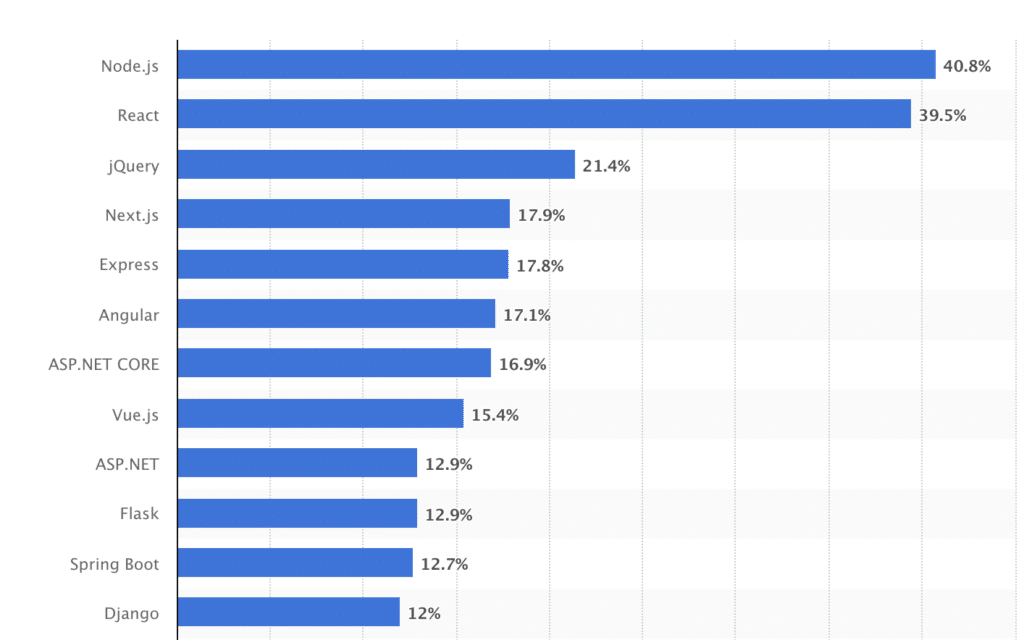Hire a Next.js Developer for Effectively Achieving Business Objectives
When a business needs to create its own software product, it faces the question – which programming language to choose? Many modern developers bet on JavaScript – a language whose popularity is confirmed by numerous rankings.
Yes, according to the PYPL Index, which takes into account the number of search queries containing “language tutorial,” JS ranks third:

The TIOBE Index ranked JavaScript in sixth place, considering the number of JS developers:

As for Statista analysts, they ranked this programming language first in popularity. According to their data, over 62% of specialists use it while working on projects:

However, the choice of programming language is just the beginning; selecting the right tech stack also requires deciding which JS framework to use for web development.
It’s worth noting that JavaScript includes many versatile tools, such as Angular, designed for developing single-page applications (SPAs), Vue.js and React for creating interactive user interfaces, Ember.js for building scalable web applications, and many others.
Today, however, we will focus on Next.js — a framework that can revolutionize the way React apps are created. From this article, you’ll learn why this tool deserves your attention and how much it costs to hire a Next.js developer.
Next.js: Concept and Key Features
Next.js is one of the most in-demand JS frameworks, featuring open-source code and acting as a complement to React, as it is built on top of it. This framework enhances React’s capabilities by adding new features that are valuable for creating modern web applications.
Next.js is frequently used in the modern world of web development. According to Statista, it ranks fourth in popularity among JS developers:

This popularity is primarily due to the significant improvements the framework provides for the JavaScript library React. It offers Next.js developers the following features:
- Server-Side Rendering (SSR). This method of page generation renders the page on the server side during a request, and then the digital solution operates as a SPA.
This approach has several advantages. First, server-side rendered pages always contain up-to-date data, as a server request is made with each reload. Second, this approach benefits SEO optimization because a fully rendered page is returned. Finally, it enhances user experience by allowing pages to load and display faster.
- Static Site Generation (SSG). Some software products do not require the entire page to be regularly generated on the server because their data doesn’t update frequently. These include sites like business cards, blogs, simple eCommerce sites, etc.
SSG is helpful in these cases, generating pages during the build process of the web application. The benefit is that pages load even faster than with SSR, and security is increased by eliminating the need for a server to process requests or generate pages.
Client-side requests can still be handled using RESTful APIs.
- Incremental Static Regeneration (ISR). This site generation concept allows for updating static content after the app development process is complete. It combines the advantages of static generation with the ability to update content without rebuilding the entire system.
- Automatic Code Splitting. The framework automatically splits large chunks of JS code into smaller fragments, optimizing performance and speeding up load times.
- CSS Support. Next.js supports various CSS solutions, including popular modules and libraries. For example, the framework works excellently with Tailwind CSS, a utility-first framework that allows software engineers to create modern web apps.
- Automatic Route Generation. Routing in Next.js is based on the file structure within the pages directory, simplifying the process significantly.
- Image Optimization. The framework includes an Image component that allows images to be displayed in the size and format optimized for the specific device. It also supports many features for working with images, including lazy loading, responsive images, and more.
- Internationalization Capabilities. Next.js enables building multilingual web resources for end users in different countries, thanks to specialized libraries and tools.
These are just some of the key features that this framework offers JS developers. Additionally, it supports TypeScript, provides instant feedback during software development, and offers a wide range of tools and plugins to extend functionality, among other things.
Of course, hiring a Next.js developer with a deep understanding of its principles can bring numerous benefits to a company.
Why Hire Next.js Developers?
If you’re still undecided about whether to hire a Next.js developer, consider the advantages that full-stack development on Next.js can bring to your business:
- Enhanced User Experience and Increased Customer Satisfaction. This is facilitated by the advanced features of the tool. For example, SSR and SSG allow for faster page loading and improved SEO effectiveness. The image optimization feature ensures that images are displayed in the optimal format.
- Scalability and Flexibility. As your business grows, you may need to scale your digital solution. Web development on Next.js provides everything necessary for this. Firstly, the framework supports a modular architecture, allowing Next.js developers to create a codebase that is easily scalable. Secondly, using ISR allows for the addition of pages without rebuilding the entire web resource.
- Faster Time-to-Market. Hiring Next.js developers will undoubtedly give you a competitive edge. Built-in routing, combined with ready-made components and plugins, accelerates the software development lifecycle.
- Cost Optimization. This is achievable thanks to the tool’s advanced functionality. For instance, built-in CSS and Sass support, along with TypeScript integration, can reduce the duration of web app development, thereby lowering costs. Additionally, you can save on server costs by utilizing static site generation.
- Reaching a Global Audience. Through internationalization, you can create a multilingual web application and conquer the market in any country.
- Ensured Relevance of Your Digital Solution. Next.js developers are well-versed in modern technologies such as JAMstack, React, and TypeScript. This enables them to create web apps with powerful functionality that can satisfy even the most demanding users. Moreover, the framework has a large community, and JS developers can always rely on their support.
- Security and Reliability of Web Applications. Bringing a Next.js developer onto your project allows you to rest easy regarding the security of your company’s and clients’ confidential data. Deployment via the Vercel platform ensures automatic HTTPS and DDoS protection. Regular updates and vulnerability fixes guarantee that your software product will remain secure over time.
- Fostering Teamwork and Enhancing Productivity. With TypeScript support, the team can ensure high code quality and reduce the number of bugs. Other features, such as fast updates and hot reloading, contribute to instant feedback, ensuring effective collaboration on the project.
Are you interested in creating scalable web applications to meet your business needs? The best solution for you is to hire a Next.js developer — such a specialist will develop an app that will undoubtedly become your competitive advantage in the market.
Use Cases for Next.js
The flexibility, rich ecosystem, and high performance of the framework enable JS developers to reach new heights in developing various types of web apps:
- E-commerce Platforms. Hiring a Next.js developer will allow you to create an online store with dynamic product lists and a shopping cart integrated with payment gateways, updated in real-time. The tool also ensures a personalized user experience.
- Educational Platforms. Next.js developers can build high-quality websites for online courses, video lectures, and testing. This powerful framework can also be used to create interactive learning resources with integrated analytics to track user engagement, progress, and learning outcomes.
- Applications for the Financial Industry. These could be web apps for personal finance maintenance, such as expense trackers, as well as complex investment platforms, payment gateways, and more.
- Corporate Websites: If you need a multi-page web resource, you can confidently turn to a development company to hire a Next.js developer. This expert can create the desired product using customizable routing, static site generation, and server-side rendering. The result—a digital solution with high performance and effective SEO optimization.
- SaaS Applications. Web development on Next.js allows you to create interactive real-time monitoring dashboards for data analysis, user management, and app settings for clients. With integration with authentication solutions, a Next.js developer can guarantee secure user authorization. Additionally, API routes allow integration with external services such as payment gateways, email, etc.
In addition to the apps mentioned above, a Next.js developer can create other web resources that will meet your business objectives. These include social media platforms, CMS, portfolio sites, and more.
Convinced that a Next.js developer is the right fit to meet your project requirements? Then it’s time to find out how much it will cost to create web applications using this framework. Let’s examine the key factors that influence Next.js developers’ earnings.
Candidate Location
The income of Next.js developers varies depending on their region. Let’s look at the average hourly rates for specialists from the USA, Eastern and Western Europe, Asia, and Africa.
- United States
Next.js developers from the USA stand out for their excellent technical skills, strong understanding of the framework and related technologies, and their ability to build scalable web apps. For their high qualifications, they earn some of the highest salaries in the world, ranging from $40 to $200+ per hour.
- Eastern Europe (Poland, Ukraine, Romania, Bulgaria, etc.)
Hiring a Next.js developer in these countries is much cheaper — depending on the candidate‘s skill level, it can cost between $15 and $80+. However, the lower rates of Eastern European developers do not compromise the quality of their work. Just like their counterparts in the United States, they are well-versed in the React ecosystem and demonstrate extensive experience in Next.js app development.
- Western Europe (Germany, France, UK, Netherlands, Scandinavia, etc.)
The price range for Next.js developers in Western European countries is comparable to that in the United States. Beginner developers can be hired for around $25 per hour, while highly qualified and experienced specialists charge $120 or more. However, it’s not just the prices that are high here — the quality of the services is also exceptional. In Western Europe, you can find specialists with deep expertise in both backend and frontend development.
- Asia (India, China, Philippines, Vietnam, Singapore, etc.)
This region offers some of the lowest prices for Next.js development services. You can find a Next.js software engineer for as little as $10 per hour in countries like India or the Philippines. However, in Singapore or Hong Kong, you may need to pay more — starting from $30. Does the choice of country affect the quality of your future web application? It’s worth noting that skilled Next.js developers can be found anywhere. What’s more important is to focus on the successful projects they’ve previously worked on, as well as their skills and knowledge.
- Africa (South Africa, Nigeria, Kenya, etc.)
Alongside Asia, Africa offers some of the most affordable Next.js developers. Specialists from the above-mentioned countries charge between $10 and $60+ per hour. So, if you’re looking for a skilled developer while keeping your project budget in check, this is the place to look.
Hiring a Next.js developer from another country is an effective way to reduce costs. However, it’s important to consider not only the economic feasibility of this decision but also other factors, such as whether your team will be comfortable working across different time zones or with significant cultural differences.
Professional Experience
The experience level of a Next.js developer directly impacts their ability to ensure the quality of the final digital solution. There are four qualification levels for Next.js developers:
- Junior Developer. These are entry-level specialists who are just starting their journey in web development. Typically, their experience does not exceed two years, and their salaries are at the lowest level, ranging from $10 to $60, depending on the country.
- Mid-Level Developer. A specialist with two to five years of experience in Next.js development and a portfolio of several successfully completed projects. This allows them to charge higher rates for their services — between $20 and $90.
- Senior Developer. A programmer with over five years of experience with the framework, strong web development skills, testing, teamwork, and self-organization. Their income ranges from $30 to $130+.
- Lead Architect. A JS developer with over a decade of experience who can not only create high-quality, scalable web applications but also manage teams, work on complex projects, and continuously improve themselves. For their experience and achievements in app development, lead architects charge from $40 to $200+ on an hourly basis.
Given this wide range of prices, it’s important to caution you: don’t hire a Next.js developer based solely on the cost of their services. Be sure to compare their qualifications with your project requirements. For some simpler projects, an entry-level or mid-level candidate may be more than sufficient, and you won’t need to pay extra for advanced skills.
Complexity of the Required Software Product
Be prepared that the cost of Next.js app development services will depend on another key factor — the complexity of the application. Let’s look at what will influence the final cost of the project:
- Functionality. Developing web applications with basic features will be less expensive than implementing extended functionality, such as integration with third-party services, handling large amounts of data, complex logic, etc.
- Architecture. Developing software with a small number of interacting components is cheaper. Microservices architecture, distributed computing, and similar approaches lead to an increase in the cost of full-stack development.
- UI/UX. A minimalist user interface is simpler and cheaper to create than one with interactive elements, animations, and unique designs.
- API integration. If your software product only requires connection to popular APIs, it won’t pose any challenges for a JS developer, meaning it won’t require additional costs. However, setting up complex APIs and synchronizing data between different systems can increase the cost of services provided by Next.js developers.
Additionally, the cost of web development on Next.js may be influenced by the need for various types of testing in the project, the complexity of maintaining the digital solution post-release, the need to use advanced additional technologies, etc.
Hiring model
There are three main hiring models for Next.js developers, each with its own pros and cons, as well as different potential costs.
- In-house Specialist.
Pros:
- Regular contact with the specialist and control over the app development process.
- Guaranteed high quality of the final product.
- Close communication within the project due to a permanent team.
Cons:
- Additional expenses for organizational matters, employee adaptation, and skill development, as well as providing necessary infrastructure.
- Freelance Platform Candidate.
Pros:
- Lower costs for services provided by freelance Next.js developers.
Cons:
- No guarantee of achieving the desired results.
- For each project, you will need to find new specialists.
- For additional services, you will most likely need to find extra experts.
- Dedicated Next.js Developers.
Pros:
- The best balance between price and quality of services
- Guaranteed results thanks to careful selection and a formally established contract.
- Access to top global talent and innovative technologies.
- Minimal effort in the search process — usually, the agency finds suitable candidates, and you only need to conduct the final interview.
Cons:
- Development costs are somewhat higher than with freelancers, but considering all the advantages of this hiring model, it’s worth it.
What to Focus On When Hiring Next.js Developers?
To ensure that the cost of Next.js development services is fully justified, it’s important to understand what to focus on when choosing the best candidate.
Technical skills
A Next.js developer should have the following hard skills to achieve all project goals:
- JavaScript Coding. The ideal candidate should be well-versed in writing code in this programming language since Next.js is a JS framework. This also includes understanding new features of the language and the ability to work with its libraries.
- React Knowledge. JS developers working on Next.js should have a deep understanding of the framework it’s built on — React. They should be familiar with concepts like components and their lifecycle, hooks, etc. They should also be able to manage application state using specialized libraries and design reusable modular components.
- Deep Knowledge of Next.js. Hire a Next.js developer who understands the routing process, image optimization, and page generation methods. Regarding the latter, they should be able to choose the one that best suits the project’s specifics.
- Understanding of HTML/CSS. Ideally, a Next.js developer should understand the semantic elements of HTML5, have strong CSS skills, and have experience working with CSS-in-JS libraries.
- TypeScript Knowledge. While not mandatory, this skill will be an advantage when considering candidates for employment. It’s desirable for Next.js developers to know its basics and understand the principles of integrating this programming language with the framework.
- API Integration. A Next.js developer should have experience working with RESTful and GraphQL APIs. They should also be competent in integrating third-party APIs and services.
- Performance Optimization. A Next.js developer should be well-versed in code-splitting strategies and understand how this capability is implemented in Next.js. Also, inquire about their knowledge of lazy loading and caching strategies.
- Web Security Assurance. Next.js developers should be able to apply best security practices, including during user authorization and authentication.
- Knowledge of SEO Best Practices. To create a modern application, a Next.js developer should be able to manage meta tags and create the correct HTML structure for search engine optimization. Familiarity with structured data and experience managing the Head component for SEO purposes is also a plus.
Soft skills
In addition to hard skills, it’s important to consider the personal qualities of a Next.js developer during the selection process. These qualities directly impact the effectiveness of their work and the overall quality of the software product. So, what characteristics should a good JS developer possess?
- strong communication skills;
- ability to work well in a team;
- problem-solving skills and the ability to find creative solutions for complex tasks;
- time management skills;
- a tendency towards continuous learning and self-improvement;
- leadership qualities (for senior developers and lead architects);
- attention to detail;
- ability to adapt to different working conditions, such as international teams, remote work, etc.
This meticulous approach to selecting a Next.js developer is crucial for building a competitive product that meets your business objectives.
Summary
The cost of Next.js development services varies depending on several factors. These include the experience and skills of the developers, their country of residence, and the complexity of the digital solution. The hiring model chosen by the employer also plays a significant role. Considering the advantages and disadvantages of each model, it can be concluded that hiring dedicated Next.js developers is the optimal choice for businesses of all sizes.



